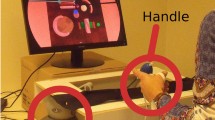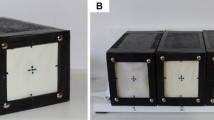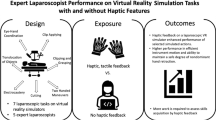Abstract
Background
What degree of fidelity must a laparoscopic simulator have to achieve a training objective? This difficult question is addressed by studying the sensory interaction of surgeons in terms of a surgical skill: tissue consistency perception.
Methods
A method for characterizing surgeon sensory interaction has been defined and applied in an effort to determine the relative importance of three components of perceptual surgical skill: visual cues, haptic information, and previous surgical knowledge and experience. Expert, intermediate, and novel surgeons were enrolled in the study. Users were asked to rank tissue consistency in four different conditions: a description of the tissue alone (Q), visual information alone (VI), tactile information alone (TI), and both visual and tactile information (VTI). Agreement between these stages was assessed by a coefficient of determination (R^2).
Results
Tissue is a determinant factor (p < 0.001) in the perception of tissue consistency, whereas the expertise of the surgeon is not (p = 0.289). Tissue consistency perception is based mainly on tactile information (TI–VTI agreement is high, R^2 = 0.873), although little sensory substitution is present (VI–VTI agreement is low, R^2 = 0.509). Agreement of Q–VI increases with experience (R^2 = 0.050, 0.290, and 0.573, corresponding with to novel, intermediate, and expert surgeons), which has been associated with the “visual haptics” concept.
Conclusions
Virtual reality simulators need haptic devices with force feedback capability if tissue consistency information is to be delivered. On the other hand, the visual haptics concept has been associated with a kind of tactile memory developed by surgical experience.







Similar content being viewed by others

References
Aggarwal R, Moorthy K, Darzi A (2004) Laparoscopic skills training and assessment. Br J Surg 91: 1549–155
Basdogan C, De S, Jung K, Muniyandi M, Hyun K, Srinivasan MA (2004) Haptic rendering—beyond visual computing: haptics in minimally invasive surgical simulation and training. IEEE Comput Graph Appl 24: 56–64
Bholat OS, Haluck RS, Murray WB, Gorman PJ, Krummel TM (1999) Tactile feedback is present during minimally invasive surgery. J Am Coll Surg 189: 349–355
den Boer KT, Herder JL, Sjoerdsma W, Meijer DW, Gouma DJ, Stassen HG (1999) Sensitivity of laparoscopic dissectors. What can you feel? Surg Endosc 13: 869–873
Gallagher AG, Smith CD (2003) From the operating room of the present to the operating room of the future: human factors lessons learned from the minimally invasive surgery revolution. Semin Laparosc Surg 10: 127–139
Grantcharov TP, Kristiansen VB, Bendix J, Bardram L, Rosenberg J, Funch-Jensen P (2004) Randomized clinical trial of virtual reality simulation for laparoscopic skills training. Br J Surg 91: 146–150
Grober ED, Hamstra SJ, Wanzel KR, Reznick RK, Matsumoto ED, Sidhu RS, Jarvi KA (2004) The educational impact of bench model fidelity on the acquisition of technical skill: the use of clinically relevant outcome measures. Ann Surg 240: 374–381
Heijnsdijk EA, Pasdeloup A, van der Pijl AJ, Dankelman J, Gouma DJ (2004) The influence of force feedback and visual feedback in grasping tissue laparoscopically. Surg Endosc 18: 980–985
Hu T, Tholey G, Desai J, Castellanos A (2004) Evaluation of a laparoscopic grasper with force feedback. Surg Endosc 18: 863–867
Kim HK, Ratter DW, Srinivasan MA (2003) The Role of Simulation Fidelity in Laparoscopic Surgical Training, 6th International Medical Image Computing and Computer Assisted Intervention (MICCAI) Conference LNCS, 15–18 November, 2003. 2878: 1–8
Kneebone R (2003) Simulation in surgical training: educational issues and practical implications. Med Educ 37: 267–277
Liu A, Tendick F, Cleary K, Kaufmann C (2003) A survey of surgical simulation: applications, technology, and education. Presence 12: 599–614
Picod G, Jambon AC, Vinatier D, Dubois P (2004) What can the operator actually feel when performing a laparoscopy? Surg Endosc 19: 95–100
Schijven M, Jakimowicz J (2003) Virtual reality surgical laparoscopic simulators: how to choose. Surg Endosc 17: 1943–1950
Seehusen A, Brett P, Harrison A (2001) Human perception of haptic information in minimal access surgery tools for use in simulation. Stud Health Technol Inform 81: 453–458
Seymour NE, Gallagher AG, Roman SA, O’Brien MK, Bansal VK, Andersen DK, Satava RM (2002) Virtual reality training improves operating room performance: results of a randomized, double-blinded study. Ann Surg 236: 458–463
Stylopoulos N, Cotin S, Maithel SK, Ottensmeyer M, Jackson PG, Bardsley RS, Neumann PF, Rattner DW, Dawson SL (2004) Computer-enhanced laparoscopic training system (CELTS): bridging the gap. Surg Endosc 18: 782–789
Tendick F, Downes M, Goktekin T, Cavusoglu MC, Feygin D, Wu X, Eyal R, Hegarty M, Way LW (2000) A virtual environment testbed for training laparoscopic surgical skills. Presence 9: 236–255
Wagner CR, Stylopoulos N, Howe RD (2002) The role of force feedback in surgery: analysis of blunt dissection. 10th Symposium on Haptic Interfaces for Virtual Environment and Teleoperator Systems (HAPTICS), 24–28, March 2002, pp 68–74
Zhang J, Payandeh S, Dill J (2003) Levels of detail in reducing cost of haptic rendering: a preliminary user study. 11th Symposium on Haptic Interfaces for Virtual Environment and Teleoperator Systems (HAPTICS), 22–23, March 2003, pp 205–212
Acknowledgment
This research was partially funded by the SINERGIA Thematic Collaborative Network (G03/135) of the Spanish Ministry of Health. The authors express their gratitude to all members of the SINERGIA consortium, especially to the staff of the Centro de Cirugía Mínimamente Invasiva (CCMI) for their help and collaboration. They also thank S. Pascual and M. C. Tejonero (Sta. María del Puerto Hospital, Cádiz), E. Bilbao (Santa Franciso Javier Hospital, Bilbao), J. A. Fatás and J Solano (Royo Villanova Hospital, Zaragoza), E. Vincent (San Carlos Hospital, Madrid), J. B. Pagador (CCMI), M. Antolín, C. Rincón, S. Rodríguez, F. Gayá (GBT-UPM (Grupo de Bioingeniería y Telemedicina:Universidad Politécnica de Madrid)), and R. Aggarwal (Department of Surgery, Oncology, and Technology, Imperial College of London).
Author information
Authors and Affiliations
Corresponding author
Rights and permissions
About this article
Cite this article
Lamata, P., Gómez, E.J., Sánchez-Margallo, F.M. et al. Tissue consistency perception in laparoscopy to define the level of fidelity in virtual reality simulation. Surg Endosc 20, 1368–1375 (2006). https://doi.org/10.1007/s00464-004-9269-z
Received:
Accepted:
Published:
Issue Date:
DOI: https://doi.org/10.1007/s00464-004-9269-z



